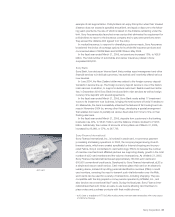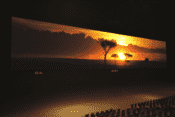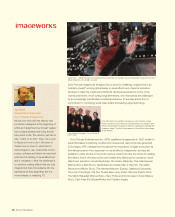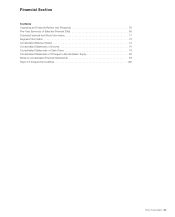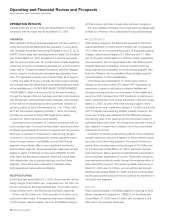Sony 2005 Annual Report Download - page 30
Download and view the complete annual report
Please find page 30 of the 2005 Sony annual report below. You can navigate through the pages in the report by either clicking on the pages listed below, or by using the keyword search tool below to find specific information within the annual report.
Sony Corporation 27
Sony’s GxL display technology offers images like none ever seen before.
At the 2005 World Exposition in Aichi, Japan, Sony is presenting the Laser Dream
Theater, where high-quality images are projected with lasers onto one of the world’s
largest screens. The ultra-wide, 2005-inch screen is big enough to show even a
whale in life-size proportions, or display the skyline at dusk over the savanna with
such realism that you believe the real thing is right before your eyes.
Behind this amazing performance is the GxL (“G-by-L”) system under development
at Sony. GxL is a projection system that combines our proprietary high-output laser
technologies and cutting-edge micro-electromechanical systems (MEMS). By using
red, green and blue (RGB) lasers, it is able to more than double the
vividness of color produced in cathode-ray tube (CRT) televisions.
For example, only the GxL system can faithfully reproduce the brilliant
deep blue of the earth as shown at the end of Laser Dream Theater’s
presentation—the same hue as found on the wings of the Morpho
butterfly (morpho menelaus) dwelling in the Amazon.
The Laser Dream Theater brings together multiple Sony Group technologies, from
those used in content planning around the Expo’s theme, “Nature’s Wisdom,” to
those used in filming, music scores and image projection. A specially developed
camera system was used to film the images, which entered a single lens and were
simultaneously recorded onto three Hi-Vision video system HDCAM-SRs. Sony Music
Entertainment Japan also produced the high-fidelity music flowing from the 86
speakers installed in the theater.
Gathering the best in technology, Sony overcame numerous difficulties to realize its
dream of delivering high-quality, beautiful imagery never before seen on so gigantic a
screen. In pursuit of achievements like this, we will continue to follow our dreams and
curiosity to bring wonder and delight to people worldwide.
GxL color
reproduction
spectrum
HDTV color
reproduction
specifications
CIE 1931 chromaticity diagram
(xy chromaticity diagram)
Spectrum
locus
It was the summer of 2002 when I first heard about Sony’s plans to participate
in the World Exposition. About the only thing decided then was that we would
try to create a 2005-inch screen to honor the year of the Expo. At the time, the
GxL prototype could only project up to 200 inches, so there was a more than
tenfold discrepancy between that and the 2005-inch goal. Nevertheless, a pas-
sion burned within us to create a laser display, a so-called “dream display,” with
our own hands. We managed to overcome many obstacles in an amazingly
short period to develop brand-new blue and green lasers.
The human optic nerve is constituted so it can respond to the three additive
primary colors—red, green and blue. The GxL system uses single wavelength
RGB lasers with outstanding color purity, enabling it to reproduce the same
colors as in real objects. The beauty it produces far exceeded even my own
expectations. When you look at the real world through a 2005-inch screen like
some huge window, you can’t help but feel a sense of wonder and excitement.
GxL System
GxL Color Reproduction
Laser Dream Theater
GxL device Magnified image of surface
Size: 25 microns
Size: 34 x 6 x 2mm
Sony Corporation 27
Morpho menelaus
© Clive S. Pratt–
The Insect Company
Naoya Eguchi
General Manager, Laser & Optics Development Department,
Photonics Development Division, Core Technology
Development Group, Micro Systems Network Company,
Sony Corporation
S ONY AR -E 0629 Adobe PageMaker 6.0J /PPC





